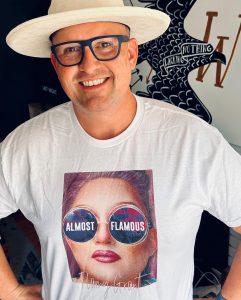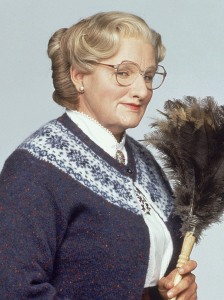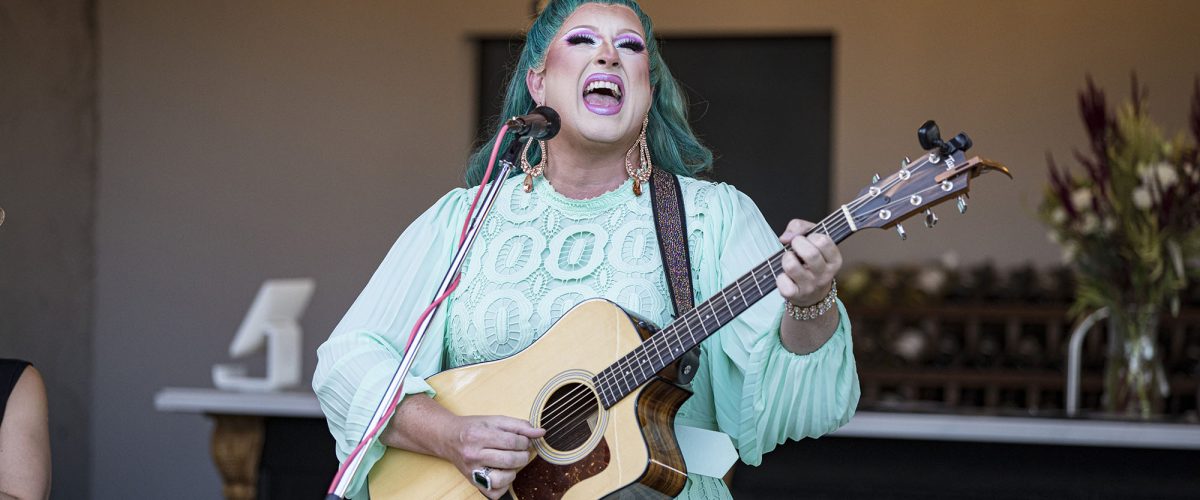From drag show bans to outcries over public schools and libraries hosting queens for reading programs and allegations of grooming, drag is in the conservative bullseye.
Last month, drag queen Flamy Grant’s meteoric rise to the apex of the Christian music charts took the conversation from court dockets and public spaces to church sanctuaries. While some progressive congregations adopted Flamy Grant’s hit song “Good Day” as a worship anthem, evangelical Christians were quick to dismiss or deride the idea of a drag queen in Christian spaces.
Drag has been legislated, maligned and feared. What it hasn’t been is examined as a form of suicide prevention or heralded as a public service, functions performers and scholars attribute to the theatrical art form.
And while having a drag queen succeed in a Christian setting has sparked discussion far beyond church boundaries, the media coverage elicited social media comments that repeated and reinforced talking points as harmful as they are inaccurate.
“Christianity and drag don’t go together. I’m sorry. I say this in love, but this isn’t biblical,” said one Twitter user. Countless comments made accusations of grooming, and another Twitter user offered a detailed description of the flames of hell directed to Flamy Grant, Derek Webb (who collaborated on “Good Day”) and me — the writer of the article being discussed.
Not a sexual thing
The association of drag and lewd behavior is an “extreme rightwing talking point that has just spread like wildfire, and it works because people do have discomfort and fear around things they don’t understand,” said Matthew Blake Lovegood, the singer-songwriter who performs as Flamy Grant. “And so if you’ve not allowed yourself to explore the world of drag and the first thing you’re really hearing about it now … is this talking point that it’s a sexual thing — that and always that and only that — I think that’s just an easy thing for folks who already have discomfort to latch onto.”
As easy as the conclusion may be, the perception of drag as deviance perpetuates the notion of drag performers — and by extension, queer people — as dangerous. In reality, drag exists, in part, as a response to the threats queer people face to their own lives.

Meredith Heller
Meredith Heller, associate teaching professor at Northern Arizona University, writes in her 2020 book Queering Drag that the art form is a vehicle that affords queer individuals “more room in which to live tolerable or joyous existences” while avoiding “the dangers of a phobic world.” She contends having drag as an outlet is “no trivial thing for trans or gender nonconforming people, especially for those who are not white, as their exceedingly high death rates from murder or suicide would suggest.”
Like other theatrical arts, drag offers performers an outlet for self-expression, social support and connection to a culturally significant tradition.

Joshua W. Rivers
Joshua W. Rivers, an anthropologist of media-making institutions and performers who has spent their academic career ethnographically studying American and Dutch drag queens in person and Icelandic drag queens online during the pandemic, said, “One sentiment was consistently present and emphasized by the performers: ‘Donning drag is a means of expressing a performative part of myself that I am unable to in my normal, daily life while also finding acceptance for the fullness of who I am in a community of welcoming and caring found-family members.”
“Having performed in drag myself, I can echo this sentiment of allowing myself to embrace a persona of myself that I had long locked away because of the community in which I was raised,” Rivers said.
The joy of drag
Heller writes that gender-bending holds a “rich potential in that it can build community, create safer spaces and, over time, lead to more possibilities for queer lives.” She contends drag offers “individual or group strength for deeply marginalized people” and could serve as a source for cultural change.
Rivers said drag, much like ballet, embodies a cultural heritage. Just as every ballet performance is informed by the history of the art form, the influence of instructors and the personal motivations of the dancer, “drag performers carry with them the lineage of drag as a form of artistic performance and self-expression as they take to their own stages, be they digital or in-person, at a bar or in a library. What differs between drag and other forms of performative media is how radically important the act of donning drag is for the performers themselves,” Rivers explained.
Lovegood describes drag as a “spotlight” in their life.
“It’s not because queerness is a thing that kills us. It’s because heteronormative culture makes being queer very hard.”
“The actual real joy that characterizes my life now is something I never experienced or understood,” Lovegood said. “I have been in dark places in my life too, just like a lot of queer people. And those suicide rates are high for a reason. And it’s not because queerness is a thing that kills us. It’s because heteronormative culture makes being queer very hard.”
‘Not grooming children’
Lovegood, who identifies as nonbinary, remembers being “shamed” out of their childhood desire to play with their mom’s makeup: “The gender binary is bad for me and has been bad for me my whole life.”

Matthew Blake Lovegood
“When you see drag performers who are in those libraries doing drag story time hour and that kind of stuff — that is volunteer time. There may be a small paycheck associated with some organizations that want to do that, but for the most part it is an act of service to the community,” said Lovegood, who has led a Drag Queen Bible Story Hour.
“They’re doing that not to groom children. We’re doing that, most of us, because we were indoctrinated. We were groomed by a whole society, a whole world that wants us to fall into those two binary categories of male or female and it didn’t work for us. And we’re thriving now outside of that binary, and so we want to provide an opportunity for kids coming up to see that that binary doesn’t have to be their only way.”
While the act of presenting a nonbinary option to children may be seen by some as a grooming act in of itself, Lovegood suggests it is “a question of how you posture it or position it.”
“It’s adding to the spectrum of possibilities that are available to kids.”
“It’s really easy for folks to say, but you’re telling kids to not be (male or female),” Lovegood said. “It’s not that. You can still be male and female. That’s fine. You can still fall into those categories. You can still like live your life in a way that reflects those social norms if that works for you. But also, it’s adding to the spectrum of possibilities that are available to kids, so that fewer kids have to go through the heart wrenching, difficult, tumultuous time growing up where they just can’t figure out where they fit. And often it can lead — for queer kids — to those high suicide rates. It’s a lifesaving act. It’s a volunteer act. And it’s the furthest thing from indoctrination.”
Men in tights
To some degree, Lovegood understands the lingering whiff of seediness attached to drag — the idea that it’s something happening in “bars you’d never go to as a straight person.” But there’s a more accurate and accessible “short line” to understanding drag: Halloween and costume parties.
“That’s your starting point,” Lovegood said. “There’s no difference between thousands of people dressing up every October 31 and going and having a good time and what drag queens do on a daily basis. We’ve just made it our lives. We figured out a way to build a livelihood around it, and it’s a fun and entertaining art form.”
“Society has always been willing to embrace men dressed as women for laughs just as long as the men in question were presumed to be straight.”
Lovegood also suggests daily life as another portal through which to view the art form.
“If I work in an office and I want to look professional, I put on professional drag. If I am a server and I have to meet a dress code for my job — that’s server drag. Stop looking at it as this weird, aberrant thing that we don’t do in a thousand other ways, like the clothes we choose to put on in the in the morning to tell other people what kind of person we want to be seen as.”
Following this logic makes Lovegood’s drag simply a work uniform. For others, it’s what they wear to make art and practice self-expression. In Lovegood’s words: “People are thriving and doing better and being happier— that’s a positive outcome and there is no negative.”

Robin Wiliams as Mrs. Doubtfire
But is drag, as the Twitter commenter suggested, inherently unbiblical?
“So many things in our life are not biblical,” Lovegood said. “That’s not the argument. Let’s just let’s talk about what’s really going on, and it’s your fear and your discomfort.”
Considering the history of gender-bending in Western entertainment, a question emerges about what, exactly, is the source of that fear and discomfort. Gender confusion was a go-to trope in Shakespeare’s plays. Vaudeville acts in the early 20th century leaned into drag. Robin Williams’ Mrs. Doubtfire character is a beloved cinema icon. And Christians have had more to say about the language Tyler Perry’s Maeda uses than the fact that Perry himself portrays her.
As LZ Granderson observed in a June article for The Seattle Times, “Society has always been willing to embrace men dressed as women for laughs just as long as the men in question were presumed to be straight.”
What’s feared is not drag. It never was drag but, rather, the queer people underneath the tiaras, boas and sequins. The queens, not the clothes, are the real targets — and that bigotry is the conversation we should be having.
Cynthia Vacca Davis teaches English at Virginia Wesleyan University. She is also a longtime journalist, writing about community news and faith for several outlets in the Hampton Roads area. She’s the author of Intersexion: A Story of Faith, Identity and Authenticity from Lake Drive Books. Learn more at cynthiavaccadavis.com or on Instagram @cynthia_vacca_davis.
Related articles:
Drag queens reading books to children are not the problem | Opinion by Susan Shaw
What Sean Feucht meant for evil, Flamy Grant experienced as good
Of drag shows and the scandal of Christmas | Opinion by Bert Montgomery


